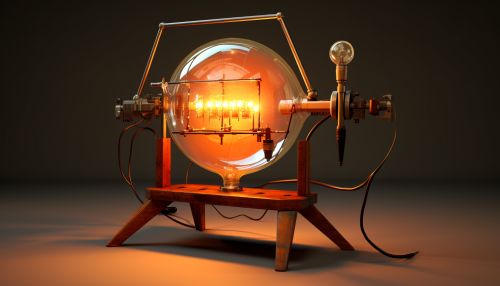Cathode Ray Tube
Introduction
The Cathode Ray Tube (CRT) is a vacuum tube containing one or more electron guns, the beams of which are manipulated to display images on a phosphorescent screen. The images may represent electrical waveforms (oscilloscope), pictures (television, computer monitor), radar targets, or other phenomena. A CRT produces images by firing a beam of electrons toward a phosphorescent screen, which then emits light to form an image.
History
The CRT has a long history, being one of the earliest technologies used to create electronic displays. The first CRTs were developed by German physicist Ferdinand Braun in 1897 and were used in oscilloscopes before finding widespread use in the first televisions and computer monitors.
Design and Operation
A CRT operates by projecting a beam of electrons onto a phosphorescent screen. The electron beam is generated by a device called an electron gun, which is located at the narrow end of the tube. The electron gun consists of a heated filament, a grid, and an anode, which collectively serve to produce and accelerate the electron beam.


The electron beam is then passed through a pair of magnetic deflection coils, which are used to steer the beam across the screen. The deflection coils are driven by a sawtooth waveform, which causes the beam to sweep across the screen in a raster pattern. When the electron beam strikes the phosphor coating on the inside of the screen, it causes the phosphor to emit light, creating an image.
Applications
CRTs have been used in a wide variety of applications, including televisions, computer monitors, oscilloscopes, and radar displays. While the use of CRTs in consumer electronics has largely been replaced by newer technologies such as LCD and OLED displays, CRTs still find use in some specialized applications.
Advantages and Disadvantages
CRTs offer several advantages over other display technologies. They have excellent color reproduction, can display images at various resolutions without scaling artifacts, and have very low input lag. However, CRTs are also bulky, heavy, consume a lot of power, and can produce significant amounts of heat. They also use high voltages, which can present safety issues.
Future of CRT Technology
While the use of CRTs has declined significantly with the advent of flat-panel display technologies, there are still areas where CRTs are used. Some retro gaming enthusiasts prefer CRTs due to their low input lag and the fact that many older games were designed with the scan lines of a CRT in mind. In addition, CRTs are still used in some professional and industrial applications where their unique characteristics are advantageous.
